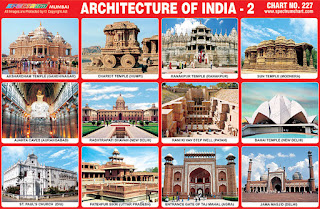Akshardham Temple (Gandhinagar)
– Akshardham Temple in Gandhinagar is a large Hindu temple complex
inspired by Pramukh Swami, the current spiritual head of BAPS
Swaminarayan Sanstha. The focal point of the complex is the
Akshardham Mandir, which measures 108 feet high, 131 feet wide and
240 feet long and features 97 carved pillars, 17 domes, 8 balconies,
220 stone beams and 264 sculpted figures.
Chariot Temple (Hampi) -
"Stone Chariot", as it is often referred is located inside
the Vittala Temple campus. The chariot is built on a rectangular
platform of a feet or so high. All around this base platform is
carved with mythical battle scenes. In front of the chariot two
elephants are positioned as if they are pulling the chariot.
Ranakpur Temple (Ranakpur)
- The renowned Jain temple at Ranakpur is dedicated to Tirthankar
Adinath. Dharma Shah, a local Jain business person started the
construction. The construction is well documented in a 1437 A.D.
copper-plate record The construction continued until 1458 A.D.
Sun Temple (Modhera) - Sun
Temple, Modhera, in Gujarat, is a temple dedicated to the Hindu
Sun-God, Surya. It is situated on the bank of the river Pushpavati.
It was built in 1026 AD by King Bhimdev of the Solanki dynasty.
Ajanta Caves (Aurangabad) -
Ajanta Caves in Aurangabad are about 30 rock-cut Buddhist cave
monuments which date from the 2nd century BC to about 480 or 650 AD.
The caves include paintings and sculptures described by the
government Archaeological Survey of India as "the finest
surviving examples of Indian art".
Rashtrapati Bhavan (New Delhi)
– The Rashtrapati Bhavan is the official home of the President of
India, located in New Delhi. It includes a mansion of 340-rooms that
has the President's official residence, halls, guest rooms and
offices.
Rani Ki Vav Step Well (Patan)
- Rani ki vav is an intricately constructed stepwell situated in the
town of Patan in Gujarat. Rani ki vav was built in the complex
Maru-Gurjara architectural style with an inverted temple and seven
levels of stairs and holds more than 500 principle sculptures.
Bahai Temple (New Delhi) -
Lotus Temple, located in New Delhi, is a Bahai House of Worship was
completed in 1986. Notable for its flower like shape, it serves as
the Mother Temple of the Indian subcontinent. Lotus Temple is open
to all, regardless of religion or any other qualification.
St. Paul's Church (Diu) -
St. Paul’s Church, Diu, is situated in Diu Island, on the west
coast of India. Church was built by the Portuguese,
its construction was completed in 1610 AD. The church is
built in the Baroque architectural style.
Fatehpur Sikri - Fatehpur
Sikri was made the political capital of the Mughal Empire by Emperor
Akbar from the period of 1571 to 1585. Fort is a blend of Mughal and
Persian architecture. Fatehpur Sikri is considered as one of the
architectural legacies of Emperor Akbar. It consists of beautiful
palaces, halls and mosques.
Entrance Gate Taj Mahal (Agra)
– The entrance gate of Taj Mahal is known as the Great Gate
(Darwaza-i rauza). The great gate stands to the north of the
entrance forecourt (jilaukhana) and provides a symbolic transition
between the worldly realm of bazaars and caravanserai and the
spiritual realm of the paradise garden, mosque and the mausoleum.
Jama Masjid (Delhi) - Jama
Masjid of Delhi, is one of the largest mosques in India. It was
built by Mughal emperor Shah Jahan. The mosque was completed in 1656
AD with three great gates, four towers and two 40 m high minarets
constructed of strips of red sandstone and white marble. The
courtyard can accommodate more than 25,000 persons.


No comments:
Post a Comment